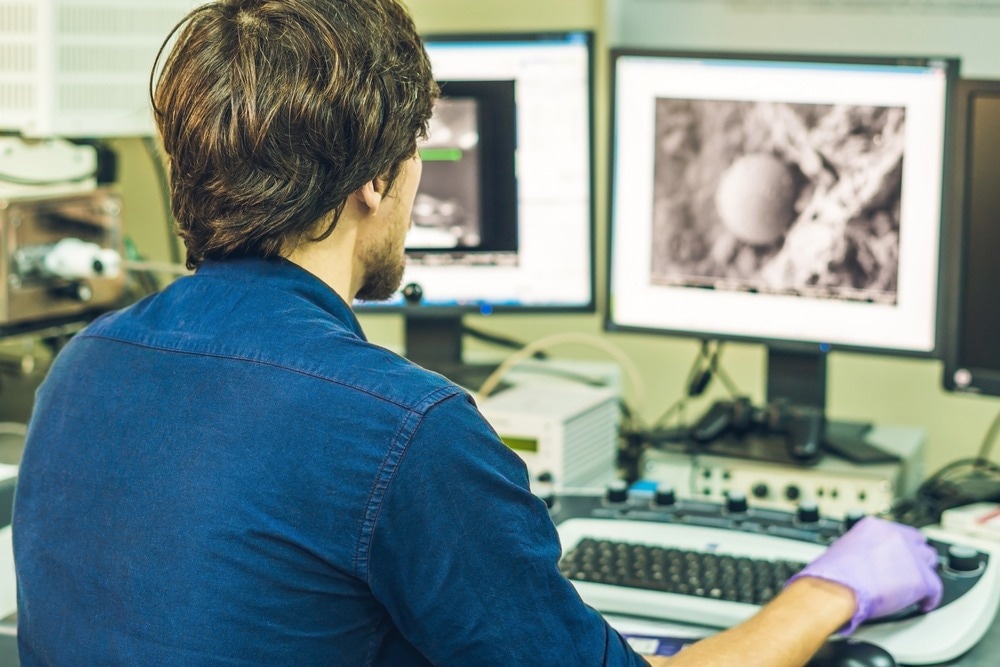Electron microscopy has been developing for almost a century, and its applications across a whole range of sciences have led to some of the most significant scientific breakthroughs in the 20th and 21st centuries. Biology is no exception. The study of cells, in particular, has been enhanced by data from cutting-edge electron microscopes for decades, and electron microscopy will likely remain essential in cells well into the future.

Image Credit: Elizaveta Galitckaia/Shutterstock.com
What is Electron Microscopy?
Electron microscopes illuminate their subjects with a beam of electrons rather than the photons that illuminate the subjects of conventional optical microscopy. As a result, these instruments allow us to investigate matter beyond the diffraction limit that constrains optical microscopy.
Because electrons have a much shorter wavelength than photons (by an order of about 100,000 times), electron microscopy is significantly more powerful than optical microscopy.
The lowest resolution optical microscopy is capable of is around 200 nm, magnifying about 2,000 times. Electron microscopy, on the other hand, has already achieved resolution down to 50 pm, magnifying subjects 10,000,000 times.
Electron microscopes manipulate a magnetic field into a defined shape, making it work like a lens in an optical microscope. The curvature in the manipulated magnetic field magnifies electrons after interacting with the subject, and this data is sensed and recorded within the device.
Specialist frame grabbers and digital cameras create an electron micrograph with the microscopy data.
As well as applications in biology, investigating the ultrastructure cells and biomaterials that only electron microscopy can investigate, the technology has also had considerable application in physics and chemistry, and is vital for the burgeoning nanotechnology industry.
Studying Cells with Electron Microscopes
Electron microscopy was first used to study cells in 1945 when it generated the first images of eukaryotic cells. Within the decade, the technology could be used to investigate cells’ internal structures by embedding samples in plastic to create ultra-thin sections.
The earliest cell studies using electron microscopes focused on cellular organelles. Scientists could describe the first organelles in greater detail using the technology were mitochondria and the endoplasmic reticulum.
Early in the development of transmission electron microscopy (TEM), scientists began developing a method for using it on brain tissues and the cells within them.
Later, in the 1960s and 1970s, scanning electron microscopy (SEM) matured to a point where it could be reliably used for biological assays in cells and cell structure.
Today, electron microscopy is integral in cutting-edge biology research, helping scientists uncover some of nature’s most minor processes and configurations.
SEM to Understand How Golgi Matrix Proteins Impact Zebrafish
Giantin, a Golgi matrix protein, was recently put under an SEM device’s electron beam to help scientists learn how it affects zebrafish’s cilia function. Scientists used SEM to image the minnow-like fish’s olfactory pit neuroepithelial cilia.
Using SEM, the team could determine how giantin, the largest of the Golgi matrix family of proteins, impacts cilia formation. When giantin was present, the zebrafish formed bulbous instead of smooth cilia tips in knockdown cells near it.
Using SEM to Find Out How Carbon Nanotube Treatment Impacts Human Macrophages
In another example of electron microscopy contributing to pioneering biological and cell research, a recent study used SEM to find out how human macrophages reacted to carbon nanotube treatments.
Alveolar macrophages remove foreign particles or microbes from the alveolar region of the lungs. These macrophages are the first to respond to threats to cells, defending them by removing the foreign matter from the area.
To image these macrophages with SEM, researchers first had to dehydrate them using ethanol. Then, they were sealed and sputter coated with electrons.
SEM images showed that untreated macrophages were spherical and had less membrane ruffling and filopodia than treated macrophages, activated with numerous filopodia and flatter.
Biologists determined from these images that long carbon nanotubes impact macrophage functionality, but not shorter ones. They could conclude that exposure to carbon nanotubes activates the bioreactivity of macrophages while also making phagocytose bacteria less effective.
Is Optical Microscopy Being Replaced?
While electron microscopy has proven to be extremely useful for investigating cells, several factors still make optical microscopy more appropriate for a given study or project.
Optical microscopy is much simpler and quicker to set up and get results from than electron microscopy. Minimal sample preparation is involved, and the required preparation is not prohibitively complex.
Optical microscopes are also much less expensive than electron microscopes. Millions of dollars of investment are required for reliable electron microscopes, while good optical microscopes can be bought for just a few hundred.
This means that optical microscopy still plays a role alongside electron microscopy, allowing for more investigations into cells worldwide in universities and school classrooms.
References and Further Reading
Bergen, D.J.M. (2017). The Golgi matrix protein giantin is required for normal cilia function in zebrafish. Biology Open. https://doi.org/10.1242/bio.025502.
Pilkington, B. (2021). A History of Electron Microscopy and the Future of the Industry. [Online] AZO Optics. Available at: https://www.azooptics.com/article.aspx?ArticleID=1981 (Accessed on 22 July 2022).
Scanning Electron Microscope Cell Images. [Online] Thermo FIsher. Available at: https://www.thermofisher.com/uk/en/home/materials-science/learning-center/applications/scanning-electron-microscopy-cell-biology-research.html (Accessed on 22 July 2022).
Sweeney, S., et al. (2015). Functional consequences for primary human alveolar macrophages following treatment with long, but not short, multiwalled carbon nanotubes. International Journal of Nanomedicine. https://doi.org/10.2147%2FIJN.S77867.
Disclaimer: The views expressed here are those of the author expressed in their private capacity and do not necessarily represent the views of AZoM.com Limited T/A AZoNetwork the owner and operator of this website. This disclaimer forms part of the Terms and conditions of use of this website.